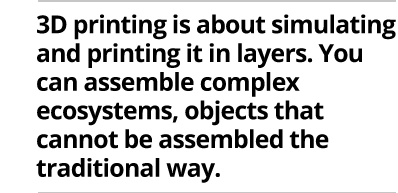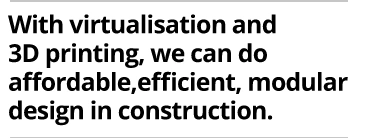There has been a lot of conversation around 3D printing. What can we expect in the immediate future?
There is a lot of misunderstanding about 3D printing. Everybody thinks that you will print the same objects you did with old technology. This is wrong. We’re not going to print what already exists, we’re going to transform it. 3D printing is about simulating and printing it in layers. You can assemble complex ecosystems, objects that cannot be assembled the traditional way. These objects will be radically different because they will be optimised with new kinds of simulation tools meant specifically for 3D printing. We can print hybrid systems. For instance, you can put a chip, or a biocell [a cellular living object] in what you’re printing, which you wouldn’t be able to do earlier.
How long has Dassault been working on 3D printing?
We have been working with 3D printing for 20 years. All of this started in secret military programmes in which 3D printing was done by advanced machines that cost a fortune. It was also used to build space and military equipment. In the last few years startups have created affordable 3D printing machines.

How did a secret military technology suddenly become mainstream?
I don’t think the defence companies and the 3D printing startups knew each other. I don’t think it was a leak. The startups hit upon an idea and executed it at a lower cost. Had there been a leak, the startups would never have bothered with the technology because it would’ve been too complex for them. They started on their own, and now the technology is evolving so quickly that with a $2,000 machine you can do amazing, high-quality work. It was quite a shock for the big defence and space players.
Which sectors in India could be the first to employ 3D printing?
There is a huge opportunity in construction. If you look at the statistics on construction technology for the last 50 years, the improvement curve is flat. That’s a problem. I see some beautiful buildings here, but they are not frugally built. With virtualisation and 3D printing, we can do affordable, efficient, modular design. For example, we’ve done a pilot for Puducherry in which virtual models of parts of the city were created to digitise infrastructure. We are also working with Centurion University to create a virtual twin of a city that’s part of the smart cities programme.
What other industries are ready for this technology in India?
Automotive, mobility, aerospace, defence, industrial equipment, and energy. There are global players with manufacturing setups in India and Indian OEMs with ambitions to go global. Among our clients, Ashok Leyland, Hero MotoCorp, Myntra, and Mahindra & Mahindra are dramatically improving their portfolio.
There are some industries which should be ready for it, but aren’t. Oil and gas and pharma for instance. The oil and gas industry has been far too rich, all over the world. They have too much money so they do not feel the need to improve. The pharma sector also has far too much, which is perhaps why they don’t discover anything new. They put money into research, but the discovery curve is synthetic.

However, the breakthrough will come from biotech. It is a new world because they are working with molecules of different sizes. So, success in a lab is no guarantee that an idea will work when it is commercialised. Scale can be a problem and that’s what makes it complex.
Can you tell us about emerging technologies such as 4D printing?
If you want to print a moving object by joining two objects, you need more than just 3D printing. You need kinematics [the branch of mechanics concerned with the motion of moving objects] and have to know how things move together. This is 4D printing or multi-D [multi-dimensional] printing. It really is additive manufacturing.
So what can multi-D printing be used for?
People are talking about 4D, or insert, or kinematics [in printing] because it is completely opening up material science. If you can put layers together, why not do the same for atoms? When you put atoms together, you create your own materials, which is what we do at our Material Science Lab. It’s a virtual lab where the system tells you whether your model/idea complies with the laws of physics and chemistry and will be successful. Once you find the traction and model, you can simulate a material and print it. This is being done in companies globally. Pharma companies, for instance, are using this to create new materials, very often for niche applications. This can be a good way to innovate.










Leave a Comment
Your email address will not be published. Required field are marked*